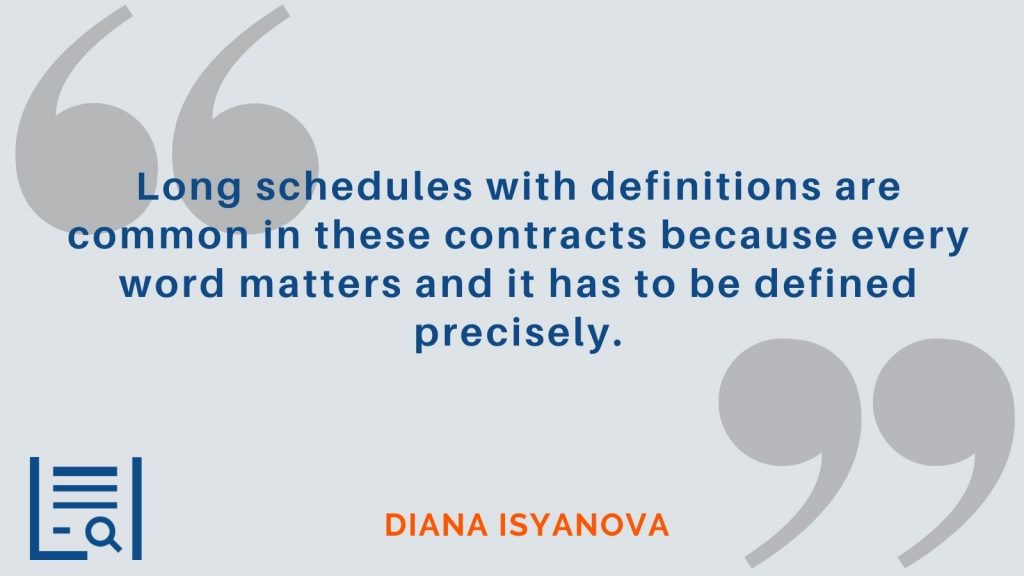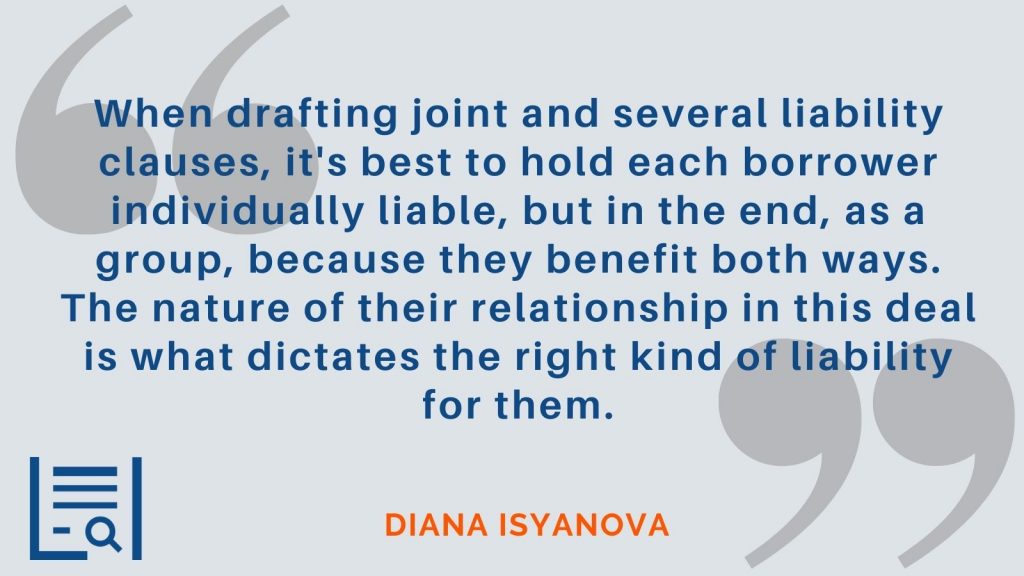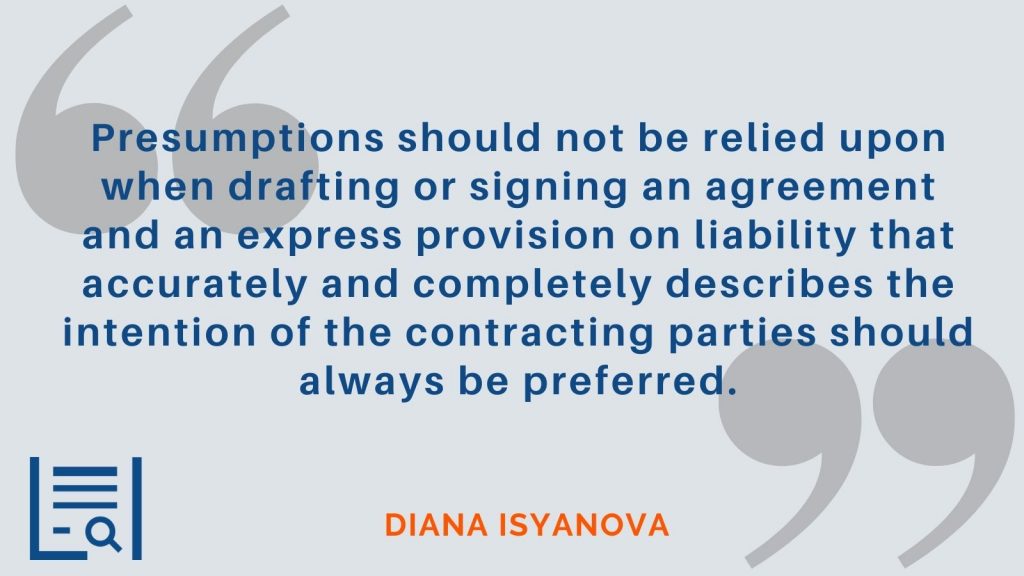Joint, Several, and Joint and Several liability can be confusing to navigate. It becomes important to understand what gets incorporated within each of these liabilities and how that affects the position of the parties. Attorney Diana Isyanova helps us understand that by tearing down an amended loan agreement. Her focus is on the liability section and how to tell if you have the right type of liability.
In addition to the Contract Teardown below, you can access Diana’s ebook on Deconstructing Joint, Several, and Joint & Several Liability.
Questions in this Episode
- How do you draft a definition clause strategically to avoid repetition in an agreement?
- What’s the difference between the three kinds of liabilities?
- What aspects of joint and several liability need to be clarified in a separate contract?
- What is the approach lawyers should take when drafting and negotiating this document?
- How do you decide what kind of liability to include in a contract?
Amended and Restated Loan Agreement: Background
The “original loan agreement” was entered into between the lenders, guarantors, and borrowers on November 20, 2008. Then the same parties entered into another agreement on June 1st, 2009. Now these parties want to consolidate those two agreements with certain changes. It’s crucial to draft a precise agreement that spells out all the provisions clearly.
Avoiding Repetition? Definitions Clause has the Answers
You’ll be surprised when you take a quick peek at the definition section. It’s rare for a contract of this caliber to have such a brief definition portion, but closer scrutiny reveals a 35-page schedule that defines all of the terms.
| (f) | The words “include”, “includes” and “including” shall be deemed to be followed by the phrase “without limitation”. The word “will” shall be construed to have the same meaning and effect as the word “shall”. |
In the short section of the definitions clause, there is one fascinating part: It defines the words ‘include,’ ‘includes,’ and ‘including,’ and that every use shall presume the phrase without limitation. It makes complete sense because no one wants to read those phrases over and over again. It expresses that a specific item is not confined to the limits provided in the writing, and it’s a wonderful approach to avoid repetition in the document and save some space.

Understanding the 3 Types of Liabilities: Joint, Several, and Joint & Several Liability
These three clauses may get confusing even to lawyers but it’s even more of a reason to learn and understand them. One of the main reasons people enter into a contract is to limit their liability or to have assurances that if something goes sideways due to the other party’s fault, the other party will be held liable.
Joint, several, and joint & several liability are three distinct clauses. Each has its benefits and place in contracts. - Diana Isanyova #ContractTeardown Click To Tweet
Joint Liability
Joint liability arises when two or more parties promise to be jointly liable for the obligation under the contract. For example, if A and B are jointly obligated to pay C $1000 and if A or B breaches, then C can choose to recover from A or B regardless of who is actually at fault. In this situation, each A and B will be liable for $1000, but once the full amount is paid by either party, both parties will be discharged from their contractual obligation. Once the full amount is recovered the deal is done.
Several Liability
Several liability arises when obligors make separate promises under the same contract and so each takes on liability for only their own obligations – almost the converse of joint liability. Here’s the picture. A and B are severally liable to C for $10,000; each is responsible for half of the obligation. So, C can recover $5000 from B, even if C has already obtained a prior judgment against A for $5,000.
Joint and Several Liability
The relationship between the parties in this type of liability is crucial because it sets the stage for the obligors – those who owe the obligation – to be held liable for the entire amount under the contract. However, the responsible parties have the right of contribution, which allows them to recover a portion or the entire amount from the non-paying obligor with whom they are jointly and severally liable.
The Main Issue in Joint & Several Liability Clauses
Defining the nature of the liability between all parties is the main issue. There is a right to recover but it’s extremely important to have that right sorted out among parties. For instance, if A and B are jointly and severally liable to C, A and B need to have a separate agreement sometimes called the ‘contribution agreement’ for a complex transaction involving many parties. For simpler and more straightforward transactions it could be just another provision in the agreement.
To have it sorted out is important in case C (or the landlord in this instance) chooses to only recover from one obligor. This often happens when one of the obligors has a deeper pocket and it’s easier to recover from them.
The following aspects regarding recovery need to be clarified in a separate contract:
- How much is to be recovered?
- What percentage or specific amount is to be recovered?
- When is it to be recovered?
- Under what conditions and limitations can recovery be done?
Make Clarifications in Separate Contracts
Section 13.12 specifically states that you are jointly and severally liable and that you have a right to contribution, but it doesn’t go any further in describing how it will work if one of the obligors is required to pay.
In a separate agreement, it’s important to:
- Clarify the rights
- Mention the interest on the amount that is not paid by the obligor
- Ask who was at fault
- Define the right to recover attorney fees if forced to litigate or to recover in general. For example, in California, attorney fees are not recoverable without an explicit provision.
| Any Borrower that makes a payment or distribution hereunder will be entitled to a contribution from the other Borrower in a pro rata amount, based on the adjusted net assets of each Borrower determined in accordance with GAAP… |
The remaining language of section 13.12 reinforces that if one of the obligors or borrowers defaults or breaches the contract the landlord can pursue any of them and hold any of the borrowers liable for the full amount.
Define Your Client’s Relationship
If you’re a lawyer drafting this, you’ll need to figure out your relationship, and it’s a good idea to state specifically that the details about your relationship are true.
One clause reads, ‘as a principal and not as the surety, guarantor or another accommodating party’ which means that each borrower is a principal to the obligation and not just to accommodate some other obligor.
Negotiating and drafting this way ensures that the cosigner will be primarily liable for the obligation and if/when it becomes necessary, landlords in this situation can recover from each or any borrower directly.

Two Important Considerations When Choosing Liability
Firstly, a contract should define the type of liability, but if it doesn’t – joint and several liability can be presumed under state laws. When all liable parties benefit in some manner from the past or present consideration, which is the bargain for value, California courts will presume joint and several liability in the absence of clear and explicit language in the contract.

There are two important factors to consider while deciding between the three categories of liabilities:
1) Who owes the obligation; and
2) The allocation of assets among the obligors .
The parties to whom the obligation is owed should prefer joint or joint and several clauses since this allows the obligee or landlord to choose which obligor or borrower to sue in this circumstance. Naturally, the obligee would prefer to demand payment from the most financially capable party because it’s easier than chasing all of the parties.
It also eliminates the need to deal with apportionment among the obligors, as some of the parties may not be solvent enough to satisfy the debt. It’s no longer a concern for the lender, and they’ll be able to collect the amount.
Show Notes
THE CONTRACT: Amended and Restated Loan Agreement
THE GUEST: Diana Isyanova is a business transactions attorney with an exceptional ability to think outside the box. She practices law in the State of California and is a member of the Orange County Bar Association and the OCBA Young Lawyers Division. You can reach her on LinkedIn or at Diana@isyanovalaw.com.
THE HOST: Mike Whelan is the author of Lawyer Forward: Finding Your Place in the Future of Law and host of the Lawyer Forward community. Learn more about his work for attorneys at www.lawyerforward.com.
If you are interested in being a guest on Contract Teardown, please email us at community@lawinsider.com.
Transcript
Diana Isyanova [00:00:00] The ones who owe the obligation are all liable for up to the entire amount of navigation under the contract.
Intro Voice [00:00:08] Welcome to the Contract Teardown show from Law Insider, where legal experts tear down contracts from some of the most well-known companies and high profile executives around the world.
Mike Whelan [00:00:21] In this episode, attorney Diana Isyanova tears down an amended loan agreement. She focuses on the liability section as we tease a new resource on law insights. We’ll tell you about that and go deep on joint, several and joint and several liability. So let’s tear it down.
Mike Whelan [00:00:39] Hey, everybody. Welcome back to the Contract Teardown show from Law Insider. I am Mike Whelan. The purpose of the show is exactly what it sounds like. We take contracts and we beat them up often mean occasionally nice to them. It’s not very common. I am here with my friend Diana Isyanova. Diana, how are you today?
Diana Isyanova [00:00:59] I’m doing well. How are you?
Mike Whelan [00:01:01] Good. I am excited because spoiler alert, we’re going to talk about a subject that you and I worked on to create a really cool resource that we will share at the end that it’s coming. It’s it’s cool. So you guys should stick around. But before we do that, we’re going to whet the appetite. We were talking about a document. Let me share it with them. Diana, it is. This document amended and restated loan agreement by it among residential for blah blah blah. It’s a residential capital loan agreement. And specifically, what we’re going to focus on today for reasons we will get into is the liability joint and several liability stuff. So, Diana, before we dig into it, why? Why are we talking about this document? When are we going to see it? Why is it important? We’ll then dig into it, but tell me about what this document is.
Diana Isyanova [00:01:52] Sure. So as you said, this is an amended and restated agreement between a group of lenders and a group of borrowers. It is a well written agreement and it’s about 80 to 90 pages long. But it shouldn’t surprise you because we’re talking a line of credit of over 900 million. So, yeah, it’s kind of important to draft that detailed agreement with clarifying all the terms and outlining some of the possible scenarios.
Mike Whelan [00:02:26] Sure. Yeah. Yeah, they dot the eyes on that kind. So, yes, a very good and long document, which is sort of depressing because I like to beat up bad documents. That’s more fun. But but we’re talking to you for reasons. Tell me about you, about your practice, your background, what brings you to documents like this and this issue of joint and several? Just just tell us about your background.
Diana Isyanova [00:02:48] OK, so my background is in transactional law. I enjoy contracts of all sorts. I enjoy drafting them and I enjoy reading them even before I decided to go to law school. I would often read the fine print on the consent form at the doctor’s office rather than reading a magazine or something. So after getting my license, I joined the large international firm where I did mostly transactional work. I left the firm right before the pandemic. Like everybody else, I had to stay at home and I have three young daughters at home and I didn’t have a job and I really couldn’t get a job because of my children. So but once I got a handle on the situation with managing my kids, keeping track of their Zoom classes and trying just to stay sane, I began doing some legal work for my friends and family. Then I got my paying client then another and another, and before I knew it, I was practicing full time.
Mike Whelan [00:03:59] I love the my kids drive me freaking crazy. Their obnoxious school is obnoxious. I wish everybody would go away. I’m going to go review some contracts, like as your outlet for I’m tired of this crap. Let’s go review some contracts. All right. Well, we’re going to dig into this particular document. And like I said, we’re going to we’re teasing a bit. A really cool resource that we’re we’re going to tell you guys about at the end. But before we do it, I know you wanted to talk about the the definitions section at the beginning. Dive into that a little bit. Tell me about the background. What are you seeing in that section?
Diana Isyanova [00:04:33] Sure. So just give a little bit of background for the contract itself, the story behind this contract. They had three original quotes, right? The original agreement was called original loan agreement, and it was entered among the lenders, guarantors and borrowers back in November 20th, 2008. Then, the same parties entered into another agreement dated June 1st, 2009. And now these parties wish to consolidate those two agreements with certain changes. So that’s the back story. And when I looked at this agreement briefly, I was surprised because the definition portion was so short. I was like, This is kind of unusual for a contract of this caliber. But then I looked closer and there was a schedule A that is comprised of about 35 pages. And that’s where all the terms are defined. And this is really common because in this contract, every word matters. And it has to be defined precisely. So there’s one interesting part in the in the short part of the definitions. It defines the word include, includes and including. And it says that every time we use that word, it shall be deemed to be followed by the phrase without limitation, which is it makes complete sense, right? Like, no one wants to read those phrases over and over and over again, including without limitation or included, but not limited to. But at the same time, it is an important phrase. And it precisely states that a specified item, a specified term, is not limited to the stated in writing parameters. So I thought it was a great way to avoid repetition in the document and also to save some space. I think removing just those two words saved at least half a page, if not more.
Mike Whelan [00:06:59] Hey, everybody, I’m Mike Whelen, I hope you’re enjoying this episode of the contract teardown show real quick, I want to ask you to do me slash you really a quick favor. Look down below you’ll see a discount code to join the Law Insider premium subscription. When you do that, you get access to more content like this. You’ll see webinars daily tips on contract drafting. Not to mention access to the world’s largest database of sample contracts and clauses. It will help you write better contracts faster if you want to do it. Right now, there’s a code below, so get there. Also, if you’re part of a larger team, if you’re in house or in a law firm, just email us where it’s sales@LawInside.com, we’ll make sure you get a deal as well. Come join us in the community. The code is below. Let’s get back to the show.
Mike Whelan [00:07:45] What an interesting fact, because like, you could probably do that over and over again in a document this long where you’re like, Hey, when we say these are what we really mean, is this really long, obnoxious legal phrase? And so just assume that we mean along obnoxious legal phrase, that’s sort of a cool way to do it. All right. Now we’re getting into some nerdiness and there are reasons, but we’re jumping down to the liability section and this issue of Joint Joint several, several special real flavell oral law. I’m just making up words now of those not actual words. All right. Give give us just like the brief and before we dig into this section on this liability section. Give us the briefest definition of these different terms and how lawyers run into them. Tell us what these terms are. OK.
Diana Isyanova [00:08:33] So these three clauses, they may get confusing even to lawyers, but it’s even more of a reason to learn about them and understand them, right? One of the main reasons people enter into a contract in general is to limit their liability or to have assurances that if something goes sideways due to the fault of the other side, the other side will be held liable. So join several and joint and several liability are three distinct clauses. Each has its benefits and each has its place in contracts. Joint liability arises when two or more parties promise to be jointly liable for the obligation under the contract. For example, if A and B are jointly obligated to pay C, let’s say, a thousand dollars, and if A or B breaches, then C can choose to recover from A or B, regardless of who is actually at fault. So in this situation, each A and B will be liable for the entire $1000. But once the full amount is paid by either party, both of the parties will be discharged from their contractual obligation. And of course, C cannot recover the $1000 from a who was not at fault, let’s say, and then turn around and Sue B, who was actually at fault. So once the full amount is recovered, the deal is done.
Mike Whelan [00:10:16] Yeah. Well, in a contract like this where you got multiple parties, I mean, it’s important to figure that out. So what we’re going to do is like, like we usually do, we’ll jump right down to the text. This this clause is found in section thirteen point twelve and it’s titled joint and several liability of borrowers, and it refers to each borrower. So I’ll start with the sentence. Each borrower acknowledges and represents that its business is integrally related to the business of the other borrower, that the availability of the commitments benefits each borrower individually and that the loans made will be for and inure to the benefit. I love that word of each of the borrowers individually and as a group. Talk to me about this section. What is it telling us about the relationship between these parties?
Diana Isyanova [00:11:02] So it’s setting the stage for joint and several liability and joint and several liability is when the parties, the obligors, right, the ones who owe the obligation are all liable for up to the entire amount of the obligation under the contract. But and that’s an important but the responsible parties have the right of contribution, meaning that they can recover from the nonpaying party, from the nonpaying obligor with whom they’re jointly and severally liable. And they can recover a portion or the entire amount. So to summarize, what you just read is each individual borrower will be held liable individually, but at. As a group, because they benefit individually and as a group, and it just makes sense to hold them liable individually.
Mike Whelan [00:12:06] So the nature of their relationship in this deal is what is sort of predicating. OK, what what kind of liability is right for that? So I would assume if I’m a lawyer and I’m drafting this kind of thing, you know, a I need to determine that what is the relationship and b that it is it a good idea in this case to really explicitly lay out, you know, these things are true about your relationship, right? So if it’s tied to the liability choice, should a lawyer very clearly state like this, this is the relationship that we’re basing that decision upon.
Diana Isyanova [00:12:40] I think it’s a good idea, especially in these long contracts. It’s definitely a good idea to set the stage and kind of reinforce, you know, those important terms. It’s OK to state what you want the provision to say, but it’s also important you say the inverse side. You know what, the provision is not meant to say. Right. So and here, after the the stage is set, the following sentence goes accordingly each borrower shall be jointly and severally liable. And you know, and in parentheses, it reinforces again, it says, as a principle and not as the surety, guarantor and other accommodating or other accommodating party. So here in the parentheses, it reinforces that each borrower is a principal to the obligation and not just to accommodate some other obligor. So this insurance that the cosigner will be primarily liable for the obligation and if and when it becomes necessary, landlords in this situation can recover from each or any borrower directly. Mm-Hmm.
Mike Whelan [00:14:00] So thinking about this background thing, then how can the parties define, you know, if this thing puts them both in a in a bundle, they might. They may not like that. They don’t want to be liable in this sense. Is there something that a lawyer can create to sort of define the nature of the liability between those parties?
Diana Isyanova [00:14:21] Absolutely, yes. And that’s the main issue here under joint and several liability. They do have this right to recover, but it’s extremely important to have that right sorted out among themselves. Right? For instance, if A and B are jointly and severally liable to see A and B need to have a separate agreement, sometimes called a contribution agreement for complex transaction involving meaningful parties, which this is right, it is normal a standalone document, but for simpler and more straightforward transactions, it could be just another provision in the agreement. Hmm. So to have it sorted out is important because in Case C or the landlord in this case chooses to only recover from one obligor, which often happens, by the way, because, you know, sometimes one of the obligor has the deeper pocket and is just easier to recover from them, a need to have rights to recover from. So how much to recover, what percentage or specific amount, when to recover and under what conditions and limitations? All of these need to be clarified in that separate contract.
Mike Whelan [00:15:52] Right? Yeah. And jumping down in this document, I mean, it starts talking about these, these contributions. It says any borrower that makes a payment or distribution hereunder will be entitled to a contribution from the other borrower in a pro-rata amount. Tell me about that section. What are you seeing in this conversation about contribution?
Diana Isyanova [00:16:10] And that’s exactly that’s exactly right. So this provision specifically states that, yes, you are jointly and severally liable, and we also want to mention that you have this right to contribution, but it doesn’t go any further like describing how it’s actually going to work if one of the obligor has to pay it. I’m sure it is. And the borrowers, they have numerous problems with single on numerous agreements on the side, describing how they’re going to apportion liability and who’s going to compensate who if one is liable. So in that separate agreement, it was very important to clarify the rights. And it’s especially important to mention things like interest on the amount that not paid by the obligor who actually was at fault and probably even the right to recover attorney’s fees if forced to litigate to recover. In general, at least in California, attorney fees are not recoverable without an explicit provision.
Mike Whelan [00:17:26] Hmm. Yeah. And I’m jumping down to the to the remaining language in this section that talks about the provisions of Section 13 12 shall, in no respect, limit the obligations and liabilities of each borrower to the lender. Parties and each borrower shall remain liable to the lender parties for the full amount of the obligation. So what’s the purpose in this kind of a sentence in terms of again, sort of limiting the rate, limiting the I don’t know if limiting the liability is the right phrase, but what do you see in that sentence?
Diana Isyanova [00:17:55] So yes, this this this last sentence in a paragraph also just reinforces that if one of the obligors one of the borrowers defaults or breaches the contract. The landlord can go after any of them and can hold liable any of the borrower for the the full amount.
Mike Whelan [00:18:23] OK, so this is a very cool document. It’s well written. As you said, there’s a lot it’s frickin’ long. Right? I mean, a lot of lawyers are not going to be dealing with this kind of a document with these kinds of stakes. And so there are decisions to be made. And sometimes those decisions are not explicit, right? People don’t say it’s either joint or several or joint and several, et cetera, et cetera, et cetera. What if it’s not there? What do we do then? Are we falling back on state law?
Diana Isyanova [00:18:49] Yes. Well, first of all, a contract should specify what type of liability, but if it doesn’t, then sometimes joint and several liability can be presumed under state laws. For example, in absence of clear and explicit language in the contract. California courts will presume joint and several liability when all liable parties benefit in some way from the past or present consideration, which is the bargain for value. A cosigner of a promissory note is also presumed to be a core obligor and not a guarantor, and will be held jointly and severally liable, meaning the cosigner will be primarily liable for the obligation where you know a guarantor is not liable unless and until the underlying borrower defaults, right? So even though these presumptions are not conclusive and may be overcome with sufficient evidence indicating otherwise, needless to say, again such presumptions should not be relied upon when drafting or signing an agreement and an express provision on liability that accurately and completely describes the intention of the contracting parties should always be preferred.
Mike Whelan [00:20:19] Got it. And that’s why my mom won’t sign on to any of my loans. OK, I’m going to spoil. I’m going to alert you to the spoil guys about what we’ve got coming before I act. Diana, I ask you the last question. So what we have coming is Diana has written a really cool guide on this issue on joint, several joint and several liability. It’s an e-book and it’s pretty long and it digs in. You can find it over at lawinsider.com/resources. It will be part of our key clauses series. So we’re going to do a series of these ebooks and you can find them all over at the resources section of Law Insider. OK, so Diana, in closing, I want you to give me a taste of that e-book of some of the advice that you given. That is e-book. What kind of practical suggestions would you give if somebody is making this choice in a document I’m drafting? I’ve got to pick joint or several joint and several, et cetera, et cetera. How do I make that choice? Any any suggestions on that just to give us a taste of what that ebooks got in there?
Diana Isyanova [00:21:21] Sure. The e-book includes some of the drafting considerations. You think how you want to draft, how you want to word those provisions, but when you’re choosing between the three, there are really two major considerations that should be taken into account. One is who owns the obligation and two the allocation of assets among the obligors, right? So the parties to whom obligation is owed should prefer either a joint or joint and several clauses. This would allow for the obligee, the landlord in this situation, the choice of which obligor or borrower to sue. Right. Naturally, the obligee would likely choose to demand payment from the most financially able party, and it’s just easier. It saves a lot of time and saves effort of pursuing all the parties, right? And some of the parties may not be even solvent enough to satisfy the debt, right? It also removes the need to deal with the apportionment among the obligors, so it’s not of the lender’s concern. You’ll be able or she’ll be able or it will be able to recover the amount it’s out. Hmm.
Mike Whelan [00:22:55] You can tell it’s a nerdy conversation when, yes, when we use obligee in a sentence, that’s what the cool kids do. All right, Diana, again, guys, if you go to lawinsider.com/resources, you will find this and other ebooks as we add them in the key clauses series. So I want people to do that. But Diana, if people want to reach out to you and nerd out very specifically about the things you nerd out very specifically on, what’s the best way to connect with you?
Diana Isyanova [00:23:25] I would love to receive some emails. It’s Diana@isyanovalaw.com.
Mike Whelan [00:23:33] Awesome. And we’ll have that information and a link to this contract and a link to the e-book. Over at lawinsider.com/resources will create a robust blog page about this, as we always do. If you go there, you’ll see transcripts of these conversations. You’ll see links and details going on at the blog. It’s a really good place, so we will see you guys next time. Also, though, if you want to be a contributor, if you want to be on this show and nerd out with me about stuff like this. Just email us. We are at Community@LawInsider.com. With that? Thank you, Diana. We will see you guys next time. Have a good day.



